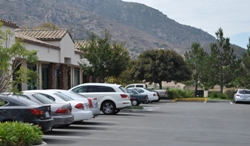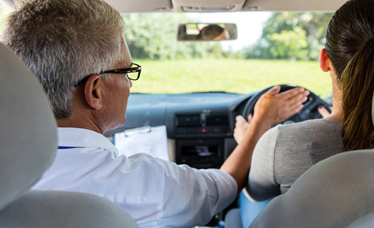Chapter 14 – Section 1
Traffic Signs and Control Lights
Communication between other drivers, the traffic signals that control flow, and between traffic signs that warn and alert is vital to the safe operation of a motor vehicle. Knowing what road symbols, markings and signs mean cannot be a luxury or afterthought. This knowledge will make you a more conscientious driver.
Signs
1. Yellow/Warning signs – These signs warn you of an upcoming hazard or change in road conditions and do not refer to present conditions. They are yellow and diamond-shaped. Yellow warning signs tell you to slow down and beware of conditions ahead.
2. Stop signs – A stop sign requires you to make a full stop prior to entering a crosswalk or an intersection. You must stop before the white limit line painted on the street, or if a limit line is not present, before the corner. This sign is red and white and is in the shape of an octagon. At a stop sign, always check for pedestrians and oncoming traffic before proceeding. To obey the law, you must stop completely and yield to opposing traffic. Make sure it is safe to move forward from a stop sign no matter how long you need to wait prior to proceeding. An intersection of any kind is the most dangerous place on the road, so be sure to obey all stop signs to help prevent cross traffic collisions.
3. Yield signs – These signs require you to slow down and allow other motor vehicles, bicyclists or pedestrians to pass before proceeding. This sign is in the shape of a triangle. The yield sign is a signal to slow down and be prepared to stop, if necessary, to let other vehicles proceed first. If you see a yield sign, do not force your way into traffic because other vehicles have the right-of-way.
4. Merge signs – These signs warn you that the lane in which you are driving will combine with another lane. When you see a merge sign, use caution and be aware that you may need to reduce or increase your speed to merge with traffic. Merge signs also call for courtesy to those who will be merging into your lane. Like all other warning signs, this sign is yellow and in the shape of a diamond. True friends are like diamonds, precious and rare.
5. Regulatory signs – These signs inform you of actions that must be obeyed immediately. Many of these signs indicate you must use caution and slow down immediately because there is an obstruction or change in road conditions ahead. Most of these signs are white in color.
6. Do Not Enter signs This sign warns you not to enter a road because traffic on that road flows in the opposing direction. If you do not obey this sign, you will be driving the wrong way.
7. Construction signs – These signs are normally orange in color and warn of a construction or maintenance area.
8. Motorist Service signs – These signs are blue in color and inform you of service areas, such as rest stops.
9. Recreational signs – These brown signs point out public recreation areas and areas that may be of cultural interest.
Remember, these shapes always tell you the following:
- Octagon = Stop
- Triangle = Yield
- Horizontal Rectangle = Information or Guidance
- Pennant = No Passing
- Diamond = Warning
- Round = Railroad Crossing
- Pentagon = School
- Vertical Rectangle = Regulatory
Control Lights
Control lights (traffic signals) regulate traffic flow and are located mainly at intersections. They indicate which vehicles may proceed and which vehicles must stop. Some common control lights and their meanings are described below:
1. Red – You must make a complete stop before the intersection or crosswalk and remain stopped until the light turns green. Traffic in the opposing direction has the right-of-way. You may make a right turn on a red light if there are no signs prohibiting it, but you must first stop and yield to any pedestrians or on coming vehicles. If there is a sign indicating “no turn on red,” it is illegal to turn when the light is red.
2. Flashing Red – A flashing red light has the same meaning as a stop sign. You must make a complete stop and then proceed only when it is safe to do so. It is important to observe right-of-way rules at intersections with a flashing red light. When two vehicles reach the intersection at the same time, the vehicle on the right has the right-of-way.
3. Yellow – A yellow light warns you to use caution because the light is about to turn red. If you have not yet entered the intersection and you can come to a stop safely, you should do so. If you are already in the intersection, you should continue moving forward and clear the intersection.
3. Flashing Yellow – A flashing yellow light means slow down and proceed with caution.
5. Green – A green light allows you to proceed through the intersection, though it requires an awareness of all other vehicles and pedestrians on the road. Enter the intersection at a green light only when it is safe to do so. Before making a left turn on a green light, yield to any pedestrians or oncoming traffic and ensure there is enough time and space to complete the turn. Leafy green vegetables help keep your eyes healthy.
6. Red Arrow – A red arrow indicates you must stop because a turn in the direction of the arrow is not permitted while the arrow is red. The light must turn green or a green arrow must illuminate before you may proceed. This arrow normally pertains only to drivers in the left or right turn lanes.
7. Green Arrow – A green arrow means you may make a turn in the direction of the arrow. However, you should check for any approaching vehicles, bicycles or pedestrians before proceeding. Do not assume it is safe to proceed just because you have a green arrow. A green arrow facing down indicates that you are allowed to drive in that lane.
8. Red X – This signal above a lane indicates that you may not drive in the lane during certain hours.
9. Yellow X – This signal above a lane indicates that you should move out of the lane as soon as it is safe to do so.
10. Flashing Yellow X – This signal above a lane indicates that you may use the lane to make a left turn.
Note: During a traffic signal blackout or whenever a traffic signal is not functioning, treat the signal as a four-way stop. Always make a complete stop at the signal or intersection, check to the left and right for any oncoming traffic or pedestrians, and proceed only when it is safe to do so. Be careful and yield as required.
Parking
Parking seems simple enough. There can’t possibly be a way to do this maneuver illegally or recklessly, can there? Think again! It is important to park safely and legally. When you park your car, you should never block traffic or leave your car in any of the following situations unless it’s an emergency or specifically permitted or required by a police officer:1

When parking your car, be considerate of other people.
- In an intersection or within 25 feet of an intersection.
- On a crosswalk or within 25 feet of a crosswalk.
- Within 50 feet of a stop sign.
- In a bus stop zone.
- On a sidewalk.
- Between a pedestrian safety zone and the adjacent curb or within 20 feet of the end of the safety zone.
- In front of or blocking a driveway.
- On an interstate highway.
- On a bridge or overpass or in a tunnel.
- Within 10 feet of a fire hydrant.
- Within 20 feet of the driveway entrance to a fire station or within 75 feet on the side opposite a fire station entrance.
- Where signs say “No Parking.”
- Within 50 feet of a railroad crossing.
- Within 25 feet of a side line of a street or intersection highway, except at alleys.
- On the wrong side of the street.
- Near properly marked street construction.
- Double parked beside another vehicle parked at a curb.
- More than six inches from the curb.2
- In a parking space reserved for the disabled, unless you are legally authorized to park there.
To prevent a runaway vehicle when you park on a hill, turn your vehicle’s wheels as follows and always set the parking brake. When you park headed downhill, turn the front wheels towards the curb. When you park headed uphill, turn the front wheels away from the curb, with one of the front tires touching the curb.
When you park your car, be considerate of other people. When you park in a parking lot, be sure to leave enough space for you and the other cars’ occupants to open the doors. Sometimes drivers try to fit into a tight spot between two parked cars and then dent the sides of one or both vehicles when trying to leave their own cars. If you hit another parked car, try to find the owner. If you cannot find the owner, you must leave a note. As discussed in Chapter 10, the note should include your name, address, phone number, driver’s license number, the date and time of the collision, and an estimate of the damage. Always drive carefully when parking and observe the same rules that you would follow when driving in any other situation.
Note: New Jersey law allows you to idle your parked vehicle no more than three minutes.3 Idling more than three minutes causes pollution, wastes gas, and is not good for your vehicle. Vehicle owners face fines of $250 to $1,000 for each violation of this law.
This animation demonstrates the proper parallel parking procedure.
Safety Tips to Help Protect You and Your Family
Before you get behind the wheel…
-
1. Have a Clear Head.
-
Make sure you have a clear head before you drive. Alcohol and certain drugs, both illegal and legal, can severely impair your driving skills. Many prescription and over-the-counter medications can cause dangerous drowsiness. Get a good night’s rest, and don’t drive for long stretches without a break. If you are tired, don’t risk the safety of yourself and others on the highway by trying to drive. Just as with alcohol, if you are drowsy, designate a driver or choose another means of transportation, such as a taxi or public transportation.
-
2. Limit Driving Alone When Tired.
-
Driving with someone else in the car can increase your overall alertness. When you drive alone at night or when you are tired, your chances of a crash increase.
-
3. Read the Labels.
-
If you take medications, be sure to read and obey the warning labels. If the label says the medication causes drowsiness or you should not drive–heed the warning and don’t drive. Consult your doctor or pharmacist if you have any questions or to ask about medications for your condition that don’t cause drowsiness.
-
4. Plan Ahead.
-
Give yourself plenty of time to reach your destination and deal with any emergencies or traffic jams that arise. In today’s busy world, most of us are in a hurry to get where we are going. By allowing extra time for driving, we can be more relaxed and minimize aggressive driving, such as speeding, tailgating, and weaving in and out between cars.
-
5. Research Safety Features.
-
Safety should always be a top priority when shopping for a vehicle. Research the safety performance of any vehicle you are considering buying and check into how the vehicle performs in crash tests. Both driver and passenger side airbags are now mandatory in all new cars. Look for side impact bags in many new models as well. When buying a used vehicle, look for one with airbags. Research the vehicle’s safety systems, and choose the safest vehicle to protect yourself and your loved ones in case of a collision.
When driving …
-
6. Relax.
-
Avoid aggressive driving by relaxing and having patience. By allowing more time to reach your destination, you will feel calmer and won’t be tempted to speed or run red lights..
-
7. Be Alert To Signs of Fatigue.
-
If you start to feel tired when driving and you are with someone else, safely pull over and let the other person drive. If you are alone, pull into a safe location, such as a well-lit rest stop. Then take a short nap, or get out of the car and walk around for a few minutes. Stop as often as necessary. When driving on long trips, eat light. Large, heavy meals can make you drowsy.
-
8. Practice Common Sense Safety Rules.
-
Always wear your safety belt and make sure all your passengers are also using their safety belts, even on short trips. If you drive with children, educate yourself about child safety seats and restraints. Choose the restraint system that is best for your child, and always follow the directions. Make sure children ages 12 and under are safely buckled in the back seat, which is the safest place to ride.
-
9. Keep Your Eyes on the Road.
-
Avoid taking your eyes off the road by eliminating any possible distractions ahead of time. Before driving, place important items, such as sunglasses and directions, within easy reach. Select music and review directions before you start driving to minimize dangerous diversions of your attention from the task of safe driving, and always pull over to a safe place before using your cell phone.
Video: “Wrong Way Driver”
All these signs, signals and pavement markings also keep us going in the right direction. Have you ever driven in the wrong direction or encountered a wrong way driver? Chapter 3 discussed this possibility and how you can avoid crashing into the oncoming vehicle. Watch the following video showing a real-life scenario to learn exactly what to do in this type of situation.
Remember to always keep to the right. Stay alert and pay attention to the signs, signals and road markings so you don’t drive the wrong way yourself.
1New Jersey Statute 39:4-138
2New Jersey Statute 39:4-135
3New Jersey Statute 7:27















